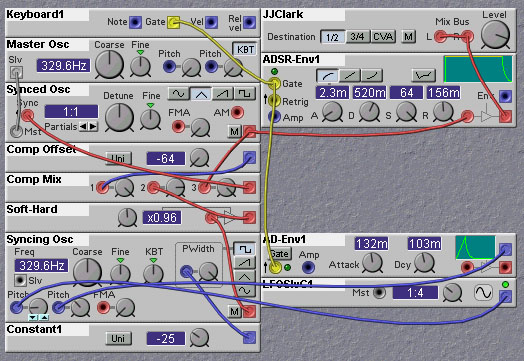
Figure 2.1. Patch illustrating a softsync technique (J. Clark).
The so-called subtractive approach to sound synthesis uses filtering of these basic waveforms to provide control over the harmonic content of a sound. A sinewave has only a single harmonic, and therefore filtering does not alter its harmonic content at all, merely the amplitude of the sound. A triangle wave has more harmonics, but with very low amplitudes, so they too are not too useful as sources for subtractive synthesis. The most useful waveforms for subtractive synthesis are the sawtooth and square (or pulse) waveforms. These waveforms have strong harmonics, suitable for alteration through filtering. A sawtooth waveform contains all harmonics of the fundamental pitch of the waveform, while the square waveform contains just the odd harmonics. A pulse waveform, with a duty cycle different than 50% also has all harmonics, even and odd. Changing the pulse width alters the relative strength of the individual harmonics, with the harmonic levels become more equal as the pulse narrows.
In the subtractive synthesis approach, variations in the spectrum of
the sound (or timbre) are usually generated by varying the
characteristics, such as cutoff frequency and resonance, of the
filters that the oscillator waveforms are passed through. While this
is effective for synthesizing many pleasing and interesting sounds,
the result is limited somewhat by the rather sparse choices of spectra
for the oscillators. Because of this, synthesizer manufacturers and
patch programmers have come up with a number of ways in which to
expand the spectral possibilities beyond those of the basic oscillator
waveforms. In this chapter we will examine some of these approaches
and show how they can be implemented in the Nord Modular.
2.1 Oscillator Sync
Oscillator Sync alters the waveform of an oscillator by resetting the
phase of the oscillator waveform when a sync pulse is received. If
this sync pulse occurs at a rate faster than the nominal oscillator
frequency, the oscillator will become locked to the sync rate. The
specific harmonic structure of the synced oscillator waveform will
depend on the nominal oscillator frequency. If the sync pulse occurs
at a rate slower than the nominal oscillator frequency, the oscillator
will not become locked to the sync rate, but will gain strong harmonic
components corresponding to the sync frequency. I will not go into
too much additional detail here, but instead refer you to the
excellent tutorial on Oscillator Sync by Rob Hordijk, found on the
Clavia web site at
www.clavia.se/nordmodular/Modularzone/Hardsync.html
and
www.clavia.se/nordmodular/Modularzone/Softsync.html.
I will give here a soft-sync technique that was not covered in the tutorial. This technique was used in the RMS (Rivera Music Systems) synthesizer as well as in the Wiard synthesizers. In this technique, the synced oscillator produces a triangle wave (which could be passed through a wave shaper to produce other waveforms). To this triangle waveform a narrow pulse from the syncing oscillator is added. The sum is compared to a reference level. If the sum exceeds this reference level, the synced oscillator is reset, or the triangle wave reversed. The probability of a syncronization event being created can be seen to be related to the amplitude of the syncing pulse as well as the amplitude of the triangle wave output of the synced oscillator. If the syncing pulse has a low amplitude, then syncing will occur only if the syncing pulse happens very close in time to the peak of the triangle waveform. Otherwise no syncing will occur. At the other extreme, if the syncing pulse has a very large amplitude, then syncing will occur on every pulse, no matter what the phase of the triangle waveform. In this case, the sync action will be that of regular hard-sync. By adjusting the amplitude of the syncing pulse one can vary the sync effect from soft to hard. This technique is illustrated by the following Nord Modular patch. It is not exactly as in the RMS and Wiard synths, since the triangle wave is reset on reception of a sync signal, rather than being reversed. But for those intrepid patchers who want more authenticity, follow the instructions in Rob Hordijk's above referenced softsync tutorial, where he describes how to reverse the slope of a triangle waveform on the Nord Modular.

For the technical minded among you, there are some ways to make sync patches sound even better. The NM, as we all know, is a digital system at heart, even though it might sound "analog" from time to time. Because of the finite sampling rate used in the NM, the syncing waveform is actually quantized in time. This means that the synced oscillator is not only synced to the syncing waveform but also to the sampling clock. At low frequencies of the syncing waveform the effect of the sampling clock sync will not be too noticeable, but at high frequencies it becomes quite significant. Rob Hordijk suggests a way to remedy this problem. The jitter caused by the syncing to the sampling clock is most noticeable at the transient that inevitably appears at the point where the syncing signal causes the synced waveform to switch. One can apply a mask, or envelope, over the synced oscillator waveform, to suppress this transient. A simple way to do this is to use a downward sawtooth as the syncing waveform and also use it as an amplitude envelope that modulates the synced waveform. This has the drawback of distorting the synced waveform, of course. An improvement can be had by crossfading two such synced waveforms, each out of phase with respect to each other. This will minimize the distorting effect of the masking. The following patch by Rob Hordijk illustrates the approach.
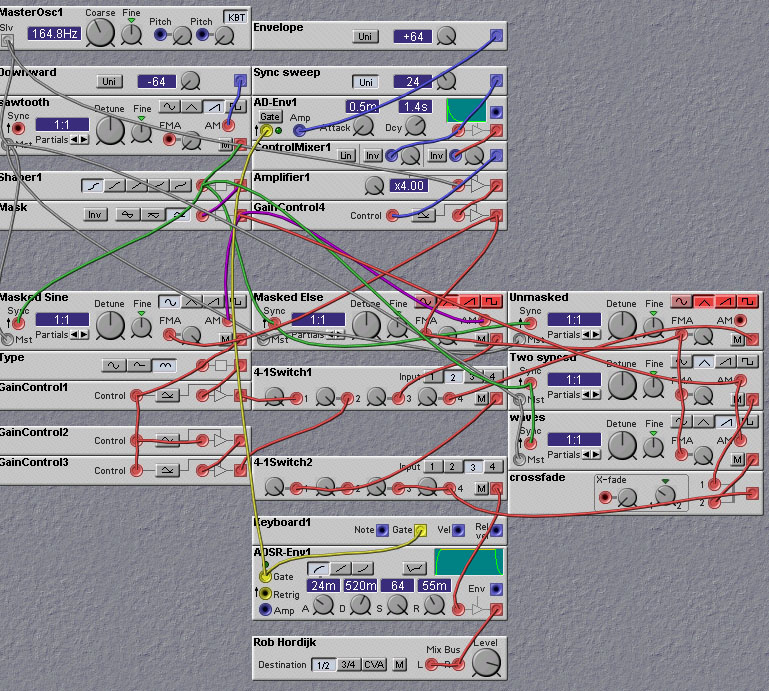
The simplest FM techniques feed the output of one sine-wave oscillator,
called the modulator, into the frequency modulation input of another,
called the carrier. If the two sinewaves have relatively harmonic frequencies,
then the resulting waveform out of the carrier will be harmonic as well.
The presence and amplitude of the carrier's harmonics is determined by
the relative frequency of the carrier and modulator. By adjusting the
ratio between these two frequencies we can get quite a range of different
harmonic structures.
For example, to emulate Brass instruments using FM, set the frequency
of the modulating signal to be the same as that of the carrier. Use an
envelope generator to set the modulation level, resulting in the
characteristic brightening of the timbre during the attack.
Instruments with cylindrical bores, such as the clarinet, have mainly
odd harmonics. To obtain this type of spectra we set the frequency of
the modulator to be twice that of the carrier. Conversely to the case
of brass instruments, the timbre of the clarinet starts out bright
then becomes duller during the attack phase. So use an inverted
envelope generator to adjust the modulation level.
To model the sound of the Bassoon and similar instruments using FM,
set the frequency of the modulator to a sub-multiple of the carrier
frequency. This will weaken the strength of the fundamental relative
to the higher harmonics. All harmonics (odd and even) are present in
these types of instruments, due to the tapered bore.
FM synthesis is capable of much more than the simple examples shown here.
The output of one carrier oscillator can be used as
a modulator waveform as well, and one can create modulation chains, where
the spectrum gets more and more complex as one moves down the chain.
Modulating the amplitude of the carrier signals in such a chain using
envelope generators or LFOs can produce quite expressive and complex time-varying
sounds.
The following patch shows a three-stage FM chain. The sound is more lively
than the simple clarinet patch given above.
One can use non-sinusoidal waveforms for the carrier and modulators, providing
an even greater variety of harmonic spectra. There is no reason one cannot use
modulator and carrier frequencies that are non-harmonic. Using these will result
in waveforms that have non-harmonic spectra, good for metallic sounds such
as bells and gongs.
The following two patches illustrate the use of non-sinusoidal modulator and
carrier waveforms. The harmonic structure is more complex than in the simple
case of sinusoidal waveforms.
Feedback is a technique that always produces interesting, if not musical,
results, and this is true for FM synthesis as well. One can modulate the
first oscillator in a modulation chain with the output of one of the other
oscillators (or with its own output, for that matter). The results of applying
feedback can be very difficult to analyze mathematically, even in the case
where all oscillator frequencies are nominally harmonic. For this reason
it is advisable to experiment, and see what comes about. Some general rules
can be found, however. First is that a little bit of feedback goes a long
way - too much feedback causes instability and even chaotic behaviour. Of
course, this might be just what you are looking for! Likewise, feedback from
an oscillator output closer to the oscillator being modulated gives a more
gentle effect than feedback from an output further down the chain.
Inserting time delays into the feedback patch can create very unpredictable
shifts in the timbre.
In the above patch Knob 2 selects the source of the feedback signal, so
that you can compare the effects of each. Selecting position 1 gives no feedback,
position 2 gives feedback from the first oscillator (i.e. self-modulation of
this oscillator), position 3 gives feedback from the second oscillator in
the chain, while selecting position 4 gives time delayed feedback from
the second oscillator.
Play around with the amount of feedback by adjusting the OscSlave1 FM Amount
control (Knob 1). If it is set too high a chaotic noisy waveform will be the
result.
The oscillator modules on the Nord Modular are specifically
designed to permit useful Frequency Modulation synthesis. There are four
types of frequency modulation inputs on these modules - "Mst",
"Pitch", "A" and "B".
The "Mst" and "Pitch" frequency modulation inputs are
logarithmic, while the "A" and "B"
inputs are linear. The Pitch input is typically used to set the basic pitch
of the oscillator, for example, from a keyboard note value. The "Mst" input
is usually connected to the "Slv" output of a master oscillator.
To understand the difference between the different input types,
consider a typical approach
to FM synthesis, where we have two sources determining the frequency of
an oscillator. The oscillator adds these two sources together to determine
the actual frequency of the oscillator. Typically, one source value is a
`stable' one that controls the basic pitch of the waveform (e.g. the "note"
being played). The other source is some waveform that varies at an audio rate.
The `stable' input should be logarithmic
(=non-linear) to accomodate a keyboardvalue on the NM. If the other modulation
input (the one connected to the audio rate signal) is also logarithmic the
waveform shape, and therefore the timbre, changes if the pitch is increased.
A low pitch will be relatively more modulated (have more harmonics) than a high
pitch. Sometimes this is desirable, for example when making a fat bass sound,
but it makes it not very useful for synthesizing a `physical
instrument'-like sound. When modulating with a linear modulating input
the harmonic content will remain stable over the complete pitch range.
But what if we selfmodulate a sine-oscillator with the FMA-input?
Opening the FMA-knob will not only change the timbre, but also
the pitch of the sound, since the average value of the sine output is
non-zero. This means that the pitch of the sound will no longer track
the note value being fed into the logarithmic pitch input. Not a good
thing for emulating standard instruments! Of course, you might be looking
for just that off-key type of sound... The FMB input is designed to
prevent such a shift in pitch when a waveform with a non-zero average
value is used as a frequency modulation source.
This input is designed to mimic the form of frequency modulation used
on the Yamaha FM-synthesizers. On these synthesizers, such as the
DX-7, the pitch doesn't change when selfmodulating. This is because Yamaha used
`phase modulation' rather than frequency modulation.
In this technique, it is not the frequency of the oscillator that is
modulated but it rather the phase of the wave. If the modulating waveform
has a non-zero average value, there will only be an (inaudible) shift in
phase, and not a shift in pitch. On the Nord Modular we can obtain
Yamaha-like FM patches by
means of the FMB input.
The FMB input does not directly modulate the phase of the oscillator.
Instead, the FMB input is passed through a highpass filter (inside the
module) and the filtered result is used to frequency modulate the
oscillator. The highpass filter removes the DC component of the modulating
signal, thereby ensuring that the average value is zero. Hence no pitch
shift will occur. Also, consider that a highpass filter acts like a signal
differentiator for signals whose frequencies are on the low
frequency cutoff slope region of the filter. Frequency modulation with the
derivative of a signal is similar to phase modulation with the signal itself
(since frequency is the time derivative of phase).
Thus, signals applied to the FMB input result in something similar to
phase modulation, as in the Yamaha systems. For modulating signals with
frequencies above the cutoff frequency of the highpass filter, the modulation
will be of frequency and not of phase, so the character of the sound created
by the modulation with high frequencies will be different than that for
modulation with low frequencies. One might want to lowpass filter the
modulating waveform to eliminate the high frequency components that will
adversely affect the sound.
Due to the great success and popularity of the Yamaha DX-7 FM synthesizer,
there has been much written on the programming of FM synths. There is also
a large number of patches available for study.
Wout Blommers has created a vast collection of Nord Modular patches
based on Yamaha DX-7 patches. These can be found, along with
additional information about FM synthesis in the section on
Emulating Classic Synths.
Rob Hordijk has also written a nice tutorial on FM synthesis which can be
accessed at
http://www.clavia.se/nordmodular/Modularzone/FMsynthesis.html.
Nonlinear elements are defined by the dependance of the element's
output on the amplitude of the input. In a linear system, if one
increases the input amplitude by a given amount, the output amplitude
is also increased by this amount. The shape of the output is not
changed due to the increase in input amplitude, just its amplitude. In
a nonlinear system this is not the case. It is therefore recommended
to apply the nonlinear element after a VCA in a signal chain. As the
VCA gain is altered, for example with an envelope or LFO, the
amplitude of the waveform is changed. Since the level of the harmonics
created by the nonlinear element depend on the amplitude of its input,
applying the nonlinearity to the output of the VCA will result in
time-varying harmonics. If the nonlinearity was applied before the
VCA, the harmonic levels would be static and uninteresting. Likewise
you should apply a filter after a nonlinear element rather than
before (although interesting effects can be obtained by feeding the
output of a resonant filter into a nonlinear element). If you are
mixing together different waveforms, it is best to apply the
nonlinearity before the mixing. This keeps the harmonics pure. If you
are using VCAs you will need one for each waveform. Of
course, interesting results can be obtained with applying
nonlinearities after mixing, but the result is harder to control and
the sound can get muddy if you are not careful.
The following patch illustrates the use of nonlinear elements in
waveshaping.
Note the use of a compressor after the nonlinear elements. The reason for this
is to even out the changes in overall amplitude that can result from the
application of the nonlinearities. Remember, the purpose of the nonlinear
elements here is to modify the shape of the waveform, but not its
amplitude. You want to use a VCA/Envelope Generator after the compressor
to provide the dynamics for the patch.
The waveforms that you use as input to the nonlinearities are not too
crucial but they do make some difference. In particular, you should avoid
using pulse or square waves as input, as their shape is not affected by nonlinear
elements, only their amplitude. In this regard, they are much like
sine waves with respect to linear filtering operations - the shape of
a sine wave is not affected by linear filtering, only its amplitude. In
mathematical jargon, sine waves are eigenfunctions of linear
time invariant systems (which is a fancy germanic way of saying that
the shape of sine waves are not altered by linear filters) and pulse (two-level)
waves are eigenfunctions of (memory-less) nonlinear mappings. Typically
triangle waves or sawtooth waves are preferable, as their linear slopes
makes predicting the effect of nonlinear operations easier than for
other waveforms. In some synthesizers, many waveforms are derived
from easy to produce triangle waves. For example, one can use a nonlinear
element that has a gradual decrease in gain with amplitude to round off
the corners of the triangle waves, producing an approximation to a sine
wave. This is also an example of a case where application of a nonlinear
process results in fewer harmonics than exist in the input!
The crossfading between the four oscillators is done via the
mathematical relation:
One can iterate the vector synthesis approach, so that the basic
waveforms used in these approaches are themselves vector synthesized
waveforms. If you have enough computational resources, you can carry
this iteration deeper and deeper, leading to fractal waveforms in the
limit. The patch shown in the following figure implements a 2-level
vector synthesis algorithm, using 16 oscillators (4 groups of 4
oscillators) with five 2-D waveform crossfade controls (4 to do the
second level waveforms, and one to do the top level waveform). LFOs
and envelopes are used to generate the crossfade controls, but, of
course, any source of control signal could be used.
In the following patch a wave sequencing algorithm is implemented to
generate a single complex waveform. In
this patch the order of the waveforms is specified, as well as the
amplitude and tuning of each step. The duration of each step is also
specified.
One of the useful ways to work with wave sequencing is to arrange the
harmonic content (and the crossfade rate) to achieve a given
effect. For example, one can place bright sounding waveforms, with
fast crossfade rates, early in the sequence, with darker waveforms,
with slow crossfades later in the sequence. This will give the typical
early-bright-late-dull sound characteristic of many natural
instruments. This arrangement is implemented in the patch below.
Of course, with the Nord Modular, the range of waveforms that we have
to work with is much more limited than on a machine like the Korg
WaveStation, so don't expect results to be as spectacular. This patch
also lacks some effects that are found on the Wavestation, such as
moving backwards and forwards through a set of waveforms, and the
specification of a controllable starting point.
Note the use of oscillator sync in the above patch. This is to model
the fact that in wavetable instruments such as the Prophet VS and Korg
Wavestation, the generation of the waveforms is implemented by
scanning of waves in the wavetable, and crossfading between waveforms
is acomplished by interpolation between different wavetable
entries. Thus each waveform is effectively synchronized, and start at
the same point.
In the patch above a 3-bit binary counter is constructed from clock divider
modules. This counter controls the crossfading of the waveforms in a
binary tree. Unfortunately, this approach requires that the crossfades
be done quickly, so there is no possibility for smoothing of the
crossfades.
The next patch, designed by Rob Hordijk, uses a different scheme for
crossfading, which permits smoothing of the crossfades. The amount,
or smoothness, of the crossfading from one step to the next can be set
by the programmer. An abrupt crossfade will give more high frequency
components than a smooth crossfade.
The crossfader
module can be used to interpolate between a current and a previous output of
a control sequencer to create a smooth wavetable oscillator. It proved that
using the first quadrant of a sine^2 function to interpolate the transitions
sounds the most smooth. Nice, as now only three DSP-cheap sinewave
slaveoscs, a gain controller, two S&H's, an inverter, the crossfade mixer
and a control sequencer to hold the table are needed to do the trick.
Using two (or more) control sequencers allows for fades between waveforms.
Its quite a cheesy sound, so to make the sound a bit grittier a fuzz is
added.
The control sequencers give up around E5 or so, from there up the patch
starts to freak out. Which can be quite nice when e.g. controlled from an
external sequencer.
A patch that implements this simple audio-rate crossfading idea is
given below. The two input oscillators are synced, so you can alter
the harmonic structure by adjusting the frequency of the synced
oscillator. Try changing the oscillator waveforms to hear the sound
produced in the various cases.
Wave Terrain synthesis is described in the book Computer Music
Tutorial, by Curtis Roads, pp.163-167. In an example of its usage,
he implements the following terrain function, and scans it with two signals, x
and y:
In this patch the two 1-D waves which define the orbit on the terrain
function are enveloped sine waves. The resulting orbit traces out two
circular paths connected by a spiral on the terrain surface. At the
beginning of the envelope, the path follows the outer circle, then
quickly moves to the inner circle during the sustain phase. Upon the
release of envelope the orbit moves to the center of the circular paths and
stays there. The circles are offset somewhat from the center of the
terrain (see the "Offset" control modules in the patch). This adds
some assymmetry to the sound and makes it more interesting.
The following patch, designed by Pere Villez, implements a basic FOF
synthesis system. A slightly more complex patch, FoFGen01Cello02.pch by the
same designer, shows the ease with which FOF synthesis can model string
instruments.
The total number of grains, the grain pitch, the inter-grain interval
(or overlap if interval is negative), grain envelope shape (attack and
decay), and grain length are commonly altered in a granular synthesis
algorithm.
The following patch, by Pelle Dahlstedt, illustrates how
Granular synthesis can be implemented on the Nord Modular.
2.2 Frequency Modulation
Frequency modulation provides an easy way to alter the harmonic
content of a sound. The sounds of many instruments are characterized
by the way in which their timbre changes over time. To generate
similar sounds using FM is often merely a matter of varying the
modulation level appropriately, using envelope generators or LFOs.
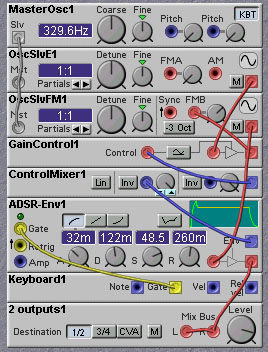
Figure 2.3. Patch illustrating a simple FM approach to obtaining a
brass-like sound (J. Clark).
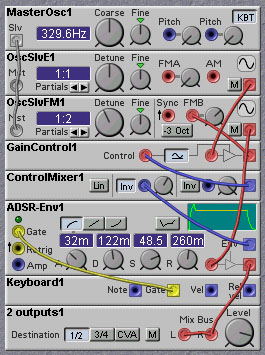
Figure 2.4. Patch illustrating a simple FM approach to obtaining a
clarinet-like sound (J. Clark).
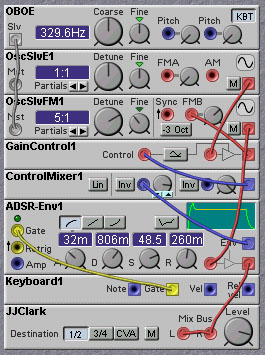
Figure 2.5. Patch illustrating a simple FM approach to obtaining an
oboe-like sound (J. Clark).
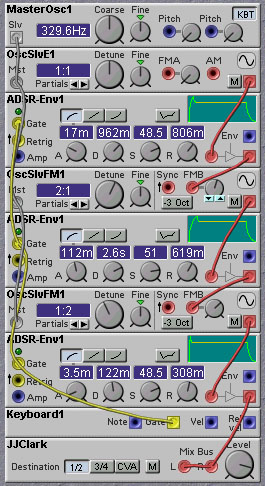
Figure 2.6. Patch illustrating the use of multiple modulation
stages in an FM patch (J. Clark).
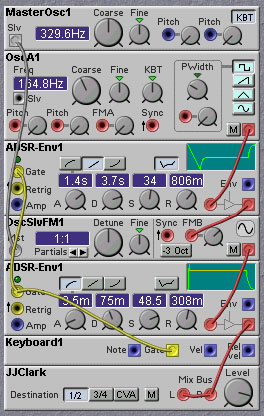
Figure 2.7. Patch illustrating non-sinusoidal modulation
waveforms in an FM patch (J. Clark).
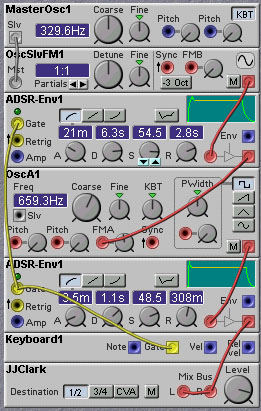
Figure 2.8. Patch illustrating non-sinusoidal carrier
waveforms in an FM patch (J. Clark).
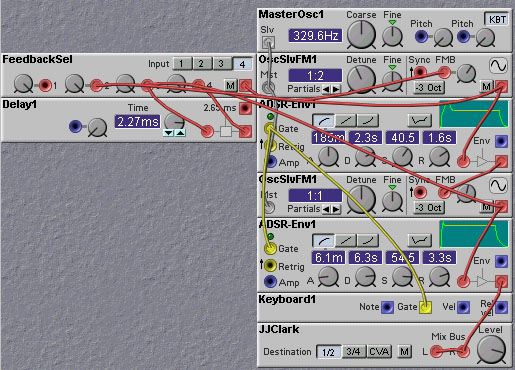
Figure 2.9. Patch illustrating the effects of feedback back to the
first oscillator in an FM modulation chain (J. Clark).
2.3 Wave Shaping
The timbre associated with a given waveform is determined primarily by
the harmonic content of the waveform. One can create new harmonics by
passing the waveform through a nonlinear element, normally referred to
as a waveshaper. The principal Nord Modular modules used for
waveshaping are the Signal Shaper, Wave-Wrapper, Quantizer, Diode,
Clip, and Overdrive modules. Note that the Ring Modulator is
not a nonlinear element, but is (bi-)linear. Nonlinearities can
be created with combinations of other modules (such as using the gain
control and ring modulator modules to multiply a signal by itself) or
by (mis-)using the Logic Modules.
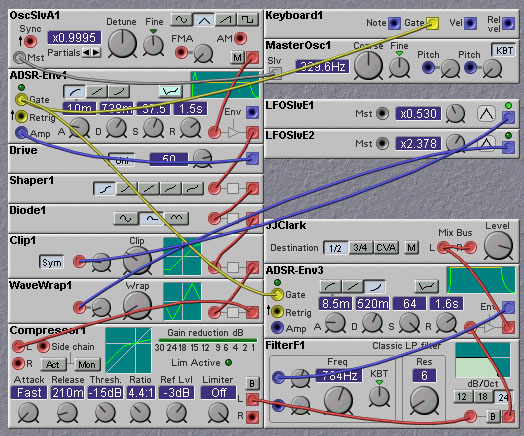
Figure 2.10. Patch illustrating waveshaping with nonlinear elements
(J. Clark).
2.4 Vector Synthesis
Vector Synthesis is a waveform modification technique that was
developed by Sequential Circuits, and first appeared in their Prophet
VS synthesizer. Vector synthesis involves the crossfading of two (or
more) waveforms under user or program control. The Prophet VS used
four waveforms, visualized as lying on the four corners of a square,
and the performer used a 2-D joystick to move within the square. When
the joystick moves close to one of the corners, the waveform
associated with that corner becomes dominant and the other waveforms
are attenuated. When the joystick is in the interior of the square, a
linear combination of the waveforms is produced. In the Prophet VS a
joystick was used to scan the four waveforms. The following patch
illustrates the vector synthesis technique.
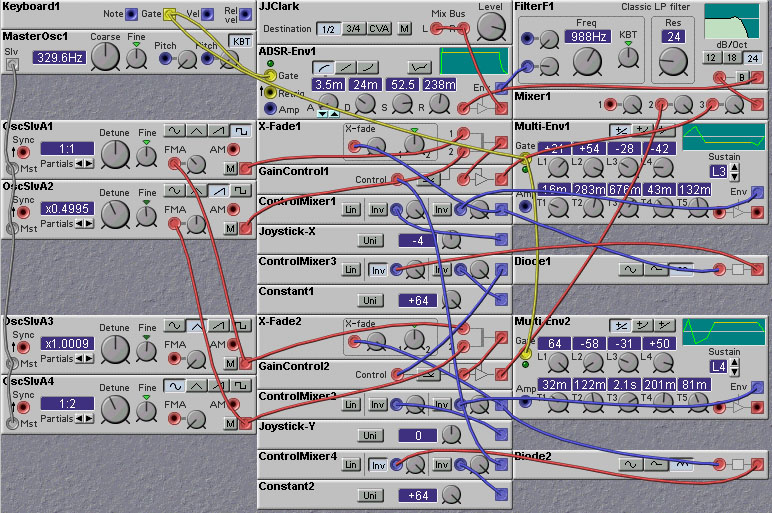
Figure 2.11. Vector synthesis patch (J. Clark).
2.5 Wave Sequencing
Wave sequencing is a descendent of vector synthesis. Wave sequencing
used up to 255 different waveforms rather than the four of vector
synthesis. In wave sequencing various waveforms from the set were
sequentially played back and crossfaded, according to some control
signal. A precursor to wave sequencing was found in the PPG Wave
synthesizer, which used a wavetable of 32 single cycle waveforms which
were selected by an index controlled by an envelope or LFO. The
waveforms in the set were all related, with little difference between
waveforms in adjoining locations in the wavetable. One of the first
instruments to employ wave sequencing was the Korg Wavestation. In
this machine, the wavetable could have up to 255 different
samples. These samples could be wildly different, and were not
neccessarily of single cycle waveforms. This flexibility comes at a
cost, however, and that is the increased complexity of designing
suitable control sequences. One can adjust the rate of crossfading
from one wave to the next, as well as the amount of time spent on each
waveform. And then there is the agonizing choice of which waveforms to
use, and in what order!
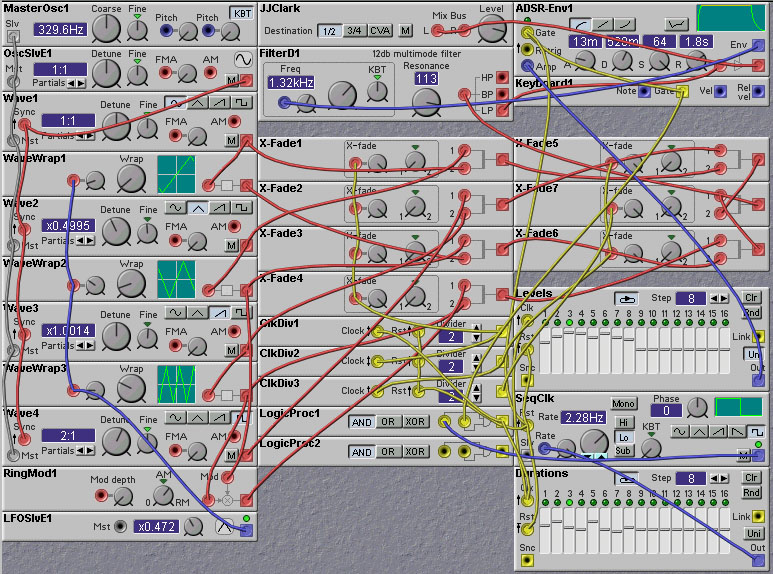
Figure 2.12. Wave Sequencing patch (J. Clark).
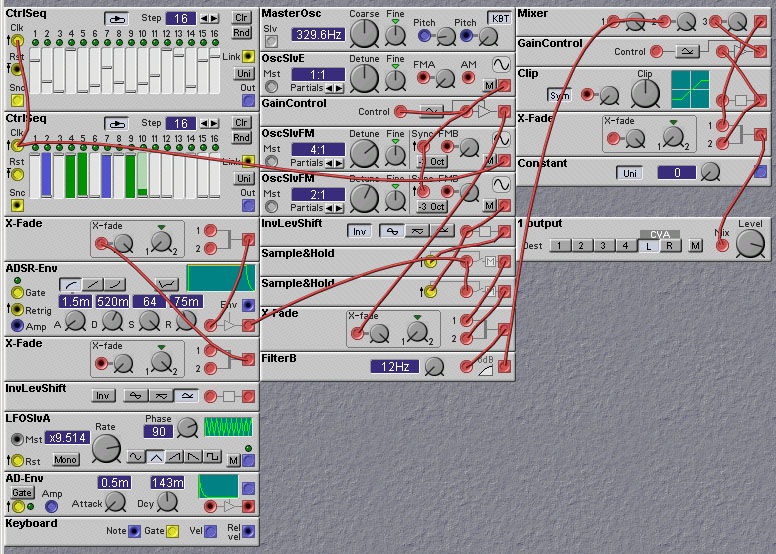
Figure 2.13. Wave Sequencing patch that allows smoothing of crossfades
from one wave to the next (R. Hordijk).
2.6 Audio-Rate Crossfading
A useful technique for obtaining interesting timbres involves the use
of crossfaders being modulated at audio rates. A crossfader combines
two input signals, s_1(t) and s_2(t) through a weighted sum controlled
by a modulating signal, m(t), as follows:
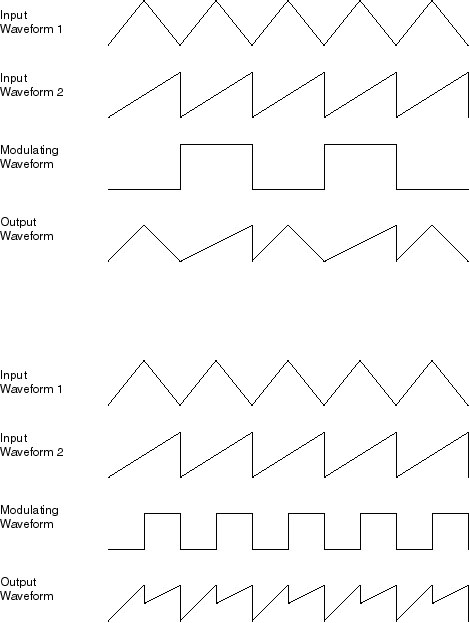
Figure 2.14. Two examples of waveform modification using audio-rate
crossfading.
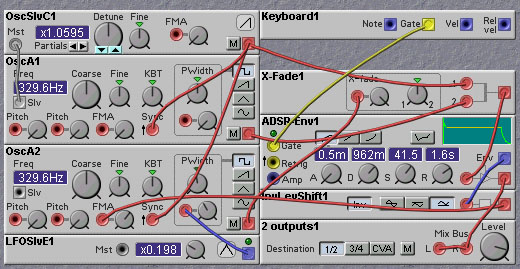
Figure 2.15. Audio-rate crossfading patch (J. Clark).
2.7 Wave Terrain Synthesis
Wave Terrain synthesis is an extension of wavetable synthesis to the
use of 2-dimensional wavetables. Now a true 2-D wavetable would
require a very large amount of memory, so wave terrain synthesis seeks
to save on memory by defining the 2-D wavetable with a surface, called
the terrain, defined by a mathematical operation called the
terrain function. Two 1-D wavetables are then used to define the
coordinates on this 2-D surface. If we refer to the two 1-D waves as x(t)
and y(t), where t is the wavetable index, then the output of the
terrain synthesis is obtained by acting on x(t) and y(t) by the
terrain function, z(x,y). The signals x(t) and y(t) define an
Orbit in the terrain, which selects which values to be output.
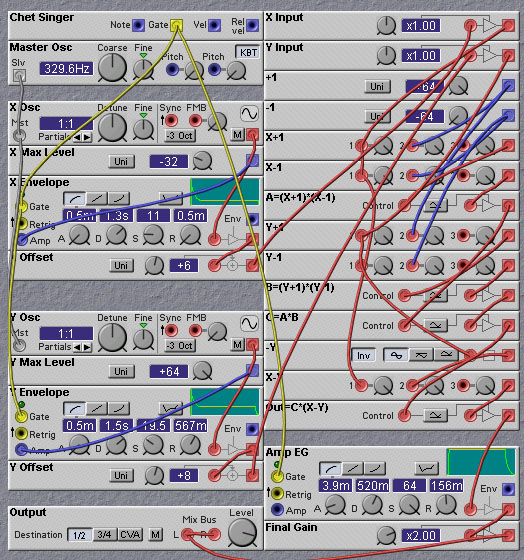
Figure 2.16. A simple Wave Terrain patch (C. Singer).

Figure 2.17. The Terrain function used in the above patch, with a
typical circular orbit.
2.8 VOSIM
For a description of the VOSIM technique, with Nord Modular patch
examples, read Rob Hordijk's tutorial on the subject,
http://www.clavia.se/nordmodular/Modularzone/VOSIM.html.
2.9 FOF (Fonction d'Onde Formantique) Synthesis
FOF synthesis is a technique for producing waveforms with a specific
spectral shape. It was developed by Xavier Rodet at IRCAM. Similar to
the VOSIM technique, sounds are produced from a sequence of
excitation pulses in the form of enveloped sine waves. The rate
of generation of the excitations specifies the fundamental frequency
of a formant region. Harmonics of this fundamental are also present,
and their amplitude is determined by the shape of the envelope that is
applied to each sinusoid in formaing the excitation pulses. The
shorter this envelope, the more gradual the falloff in harmonic
amplitude in the frequency domain. Lengthening the envelope, on the
other hand, reduces the harmonic amplitudes quickly in the the
frequency domain, narrowing the width of the formant region. Other
details of the local envelope shape, such as the rise and fall rates,
affect the shape of the harmonic amplitude curves in subtle ways,
allowing for precise control of the harmonic structure. Of course, the
shape of the local envelope can be changed over time, permitting
dynamic timbres to be produced. Typically, many such excitation
waveforms are added together, each providing a different formant
region. In this way vowel-like vocal sounds can easily be created,
although non-vocal sounds are also possible.
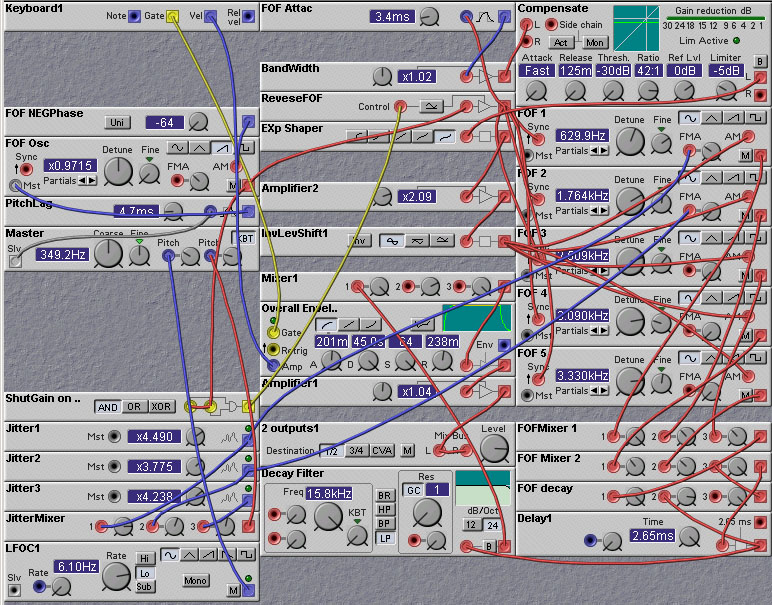
Figure 2.18. A FOF patch (P. Villez).
2.10 Granular Synthesis
Granular synthesis is similar in many ways to the VOSIM and FOF
synthesis techniques described above.
A grain is a short piece of a waveform (which can come from any
source, but is typically a sample stored in a wavetable) which has
a short-time envelope applied to it. Each grain is generally 10-100
milliseconds in length. Many individual grains are combined with
various relative timings and overlaps to create a composite "cloud" of
sound. The individual grains can be modified by altering their
envelope (lengthening or shortening, changing the rise and fall time,
etc) and changing the frequency of the grain waveform (by changing the
scan rate of the wavetable, for example). The relative positions of
the grains in the cloud can be altered as well. All of these changes
can either be deterministic or random.
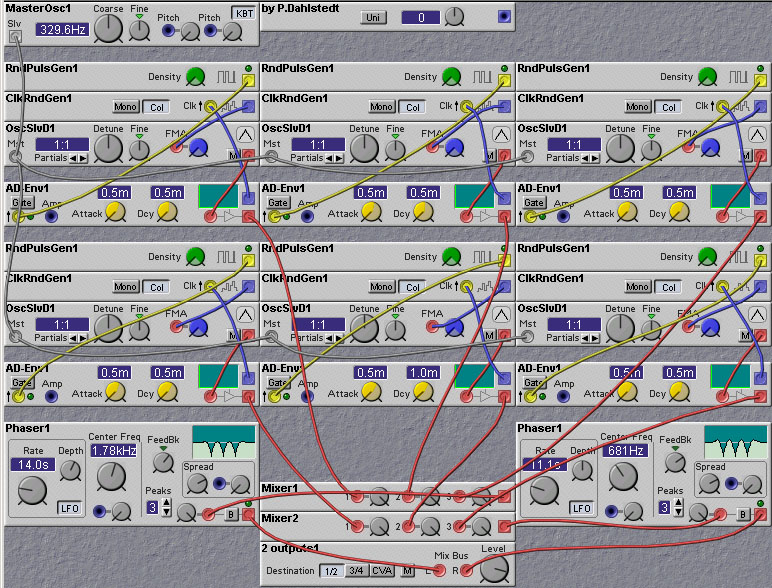
Figure 2.19. A Granular synthesis patch (P. Dahlstedt).
[Prev (Introduction)][Next (Filter Techniques)][Table of Contents]

(c) James Clark 2003